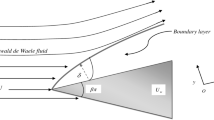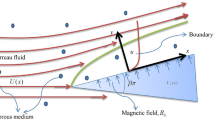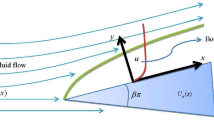Abstract
We consider the two-dimensional laminar boundary-layer flow of power-law fluid over a moving wedge in which the uniform magnetic field is applied normally to the flow. The motion of the mainstream and wedge is approximated in terms of the power of the distance from leading boundary-layer edge which helps to reduce the governing partial differential equations to an ordinary differential equation. No analytic solution is feasible due to high nonlinearity; therefore, the numerical simulations are sought by Chebyshev collocation and shooting techniques. These techniques provide a means to assess physical insights into the hydrodynamics of complex flows and particularly the Chebyshev collocation method enables the construction of efficient tools suitable for nonlinear problems. This method often leads to a matrix-based analysis and an iterative technique needs to be employed to solve the problem. The various results on the physical parameters show that the shear-thinning and shear-thickening solutions are demarcated by the Newtonian fluid. It is also noticed that the system yielded a non-unique solution structure for a given set of parameters. However, the non-uniqueness of the solutions disappears for increasing the magnetic field. To assess the nature of the non-unique solutions, it is important to perform the linear stability using large-time asymptotics. This analysis gives as to which of these solutions is practically feasible and models the flow. Eigensolution-based analysis reveals that the first solution is always stable while the other one leading to unstable mode. The results further show that an increase in the magnetic field stabilizes the fluid flow over the moving wedge and promotes the unique solution to the problem. Further, the obtained numerical results are compared by examining the large λ asymptotics. It is observed that there is a qualitative comparison between solutions. The hydrodynamics behind the magnetic field and non-Newtonian fluid are discussed in detail.














Similar content being viewed by others
References
Bird RB, Armstrong RC, Hassager O (1987) Dynamics of polymeric liquids. Vol. 1: fluid mechanics, second edition,. Wiley-Interscience publication, Hoboken
Schowalter WR (1960) The application of boundary-layer theory to power-law pseudoplastic fluids: similar solutions. AIChE J 6(1):24–28
Sakiadis BC (1961) Boundary-layer behavior on continuous solid surfaces: I. Boundary-layer equations for two-dimensional and axisymmetric flow. AIChE J 7(1):26–28
Andersson HI, Aarseth JB, Braud N, Dandapat BS (1996) Flow of a power-law fluid film on an unsteady stretching surface. J Non-Newtonian Fluid Mech 62(1):1–8
Ali ME (1995) On thermal boundary layer on a power-law stretched surface with suction or injection. Int J Heat Fluid Flow 16(4):280–290
Denier JP, Dabrowski PP (2004) On the boundary-layer equations for power-law fluids. Proc R Soc Lond Ser A Math Phys Eng Sci 460(2051):3143–3158
Ishak A, Nazar R, Pop I (2011) Moving wedge and flat plate in a power-law fluid. Int J Non-Linear Mech 46(8):1017–1021
Andersson HI, Bech KH, Dandapat BS (1992) Magnetohydrodynamic flow of a power-law fluid over a stretching sheet. Int J Non-Linear Mech 27(6):929–936
Liao SJ (2003) On the analytic solution of magnetohydrodynamic flows of non-newtonian fluids over a stretching sheet. J Fluid Mech 488:189–212
Cortell R (2005) A note on magnetohydrodynamic flow of a power-law fluid over a stretching sheet. Appl Math Comput 168(1):557–566
Xu H, Liao S-J, Pop I (2006) Series solution of unsteady boundary layer flows of non-newtonian fluids near a forward stagnation point. J Non-Newtonian Fluid Mech 139(1–2):31–43
Mahmoud MAA, Mahmoud MAE (2006) Analytical solution of hydromagnetic boundary-layer flow of a non-newtonian power-law fluid past a continuously moving surface. Acta Mech 181:83–89
Amaouche M, Nait-Bouda F, Sadat H (2007) Oblique axisymmetric stagnation flows in magnetohydrodynamics. Phys Fluids 19(11):114106
Reddy BS, Kishan N, Rajasekhar MN (2012) MHD boundary layer flow of non- Newtonian power-law fluid on a moving flat plate. Adv Appl Sci Res 3(3):1472–1481
Griffiths PT, Stephen SO, Basson AP, Garrett SJ (2014) Stability of the boundary layer on a rotating disk for the power-law fluids. J Non-Newtonian Fluid Mech 207:1–6
Griffiths PT (2015) Flow of a generalized newtonian fluid due to a rotating disk. J Non-Newtonian Fluid Mech 221:09–17
Riley N, Wiedman PD (1989) Multiple solutions of the Falkner-Skan equation for a flow past a stretching boundary. SIAM J Appl Math 49(5):1350–1358
Sachdev PL, Kudenatti RB, Bujurke NM (2008) Exact analytic solution of a boundary value problem for the falkner-skan equation. Stud Appl Math 120(1):1–16
Kudenatti RB, Noor-E-Misbah G, Bharathi MC (2020) Boundary-layer flow of the power-law fluid over a moving wedge: a linear stability analysis. Eng Comput 2020:1–14
Yuan SW (1988) Foundations of fluid mechanics. Prentice-Hall of India, New-Delhi
Weidman PD, Kubitschek DG, Davis AMJ (2006) The effect of transpiration on self-similar boundary layer flow over moving surfaces. Int J Eng Sci 44(11–12):730–737
Sezer M, Kaynak M (1996) Chebyshev polynomial solutions of linear differential equations. Int J Math Educ Sci Technol 27(4):607–618
Akyüz-Daşcıoğlu Ayşegül, Çerdi Handan et al (2011) The solution of high-order nonlinear ordinary differential equations by chebyshev series. Appl Math Comput 217(12):5658–5666
Burden R, Faires JD (2004) Numerical analysis. Cengage Learning, Canada
Kudenatti RB, Kirsur SR, Achala LN, Bujurke NM (2013) MHD boundary layer flow over a non-linear stretching boundary with suction and injection. Int J Non-Linear Mech 50:58–67
Crane LJ (1970) Flow past a stretching plate. Zeitschrift für Angew Math Phys ZAMP 21(4):645–647
Kudenatti RB, Awati VB, Bujurke NM (2011) Approximate analytical solutions of a class of boundary layer equations over nonlinear stretching surface. Appl Math Comput 218(6):2952–2959
Ishak A, Jafar K, Nazar R, Pop I (2009) MHD stagnation point flow towards a stretching sheet. Phys A Stat Mech Appl 388(17):3377–3383
Yao C, Li B, Wei H-R, Junjie L (2019) Power-law fluids over a viscous sheet with mass suction/blowing: multiple solutions. AIP Adv 9(11):115121
Makinde OD, Khan ZH, Ahmad R, Khan WA (2018) Numerical study of unsteady hydromagnetic radiating fluid flow past a slippery stretching sheet embedded in a porous medium. Phys Fluids 30(8):083601
Sharma R, Ishak A, Pop I (2014) Stability analysis of magnetohydrodynamic stagnation-point flow toward a stretching/shrinking sheet. Comput Fluids 102:94–98
Awaludin IS, Ishak A, Pop I (2018) On the stability of mhd boundary layer flow over a stretching/shrinking wedge. Sci Rep 8(1):1–8
Turkyilmazoglu M (2009) Primary instability mechanisms on the magnetohydrodynamic boundary layer flow over a rotating disk subject to a uniform radial flow. Phys Fluids 21(7):074103
Acknowledgements
The authors are thankful to the SERB (Science and Engineering Research Technology Board), New Delhi, India, for providing financial assistance under Core Research Grant (CRG/2019/004806) to carry out our work. Authors would like to thank the referees who gave useful comments which improved the article.
Author information
Authors and Affiliations
Corresponding author
Ethics declarations
Conflict of interest
The authors declare that they have no conflict of interest.
Additional information
Publisher's Note
Springer Nature remains neutral with regard to jurisdictional claims in published maps and institutional affiliations.
Appendix
Appendix
1.1 Derivation of boundary layer equations
Consider the Navier–Stokes equation in the vector form where the symbols have their usual meaning (as discussed earlier in the formulation Sect. 2.1).
The stress tensor \(\tau\) is defined as
where \(\dot{\gamma }\) is the second invariant of strain tensor. We now refer the non-Newtonian viscosity \(\mu\) as an apparent viscosity \(\mu _{app}\), in which case, we have
Hence,
where
By introducing the following non-dimensional variables
where L, U are the reference length and velocity, respectively, and \(\delta\) is of the order of boundary layer thickness to get the following equations:
and the apparent Reynolds number is
Neglecting terms of order \(O(\delta )\) and small on the bases that Re is large, we obtain the following boundary layer equations:
Here \(^*\) has been dropped for simplicity and Eq. (55) infers the pressure varies towards the mainstream flow direction alone. Hence we arrive at (3).
Rights and permissions
About this article
Cite this article
Kudenatti, R.B., Misbah, N.E. & Bharathi, M.C. Stability of hydromagnetic boundary layer flow of non-Newtonian power-law fluid flow over a moving wedge. Engineering with Computers 38, 1107–1126 (2022). https://doi.org/10.1007/s00366-020-01094-9
Received:
Accepted:
Published:
Issue Date:
DOI: https://doi.org/10.1007/s00366-020-01094-9




